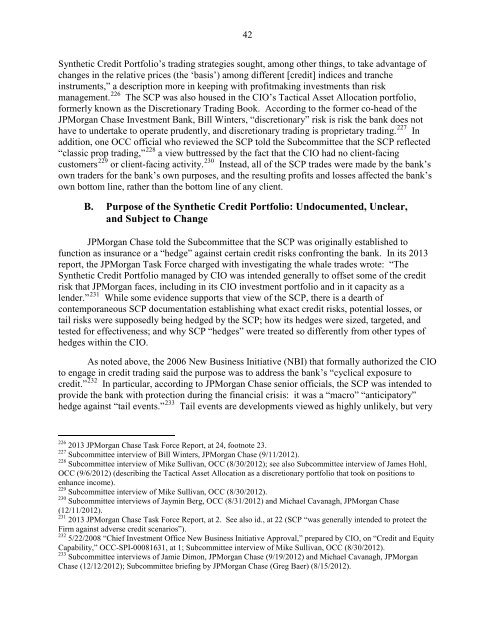JPMORGAN CHASE WHALE TRADES: A CASE HISTORY OF DERIVATIVES RISKS AND ABUSES
JPMORGAN CHASE WHALE TRADES: A CASE HISTORY OF DERIVATIVES RISKS AND ABUSES
JPMORGAN CHASE WHALE TRADES: A CASE HISTORY OF DERIVATIVES RISKS AND ABUSES
Create successful ePaper yourself
Turn your PDF publications into a flip-book with our unique Google optimized e-Paper software.
42<br />
Synthetic Credit Portfolio’s trading strategies sought, among other things, to take advantage of<br />
changes in the relative prices (the ‘basis’) among different [credit] indices and tranche<br />
instruments,” a description more in keeping with profitmaking investments than risk<br />
management. 226 The SCP was also housed in the CIO’s Tactical Asset Allocation portfolio,<br />
formerly known as the Discretionary Trading Book. According to the former co-head of the<br />
JPMorgan Chase Investment Bank, Bill Winters, “discretionary” risk is risk the bank does not<br />
have to undertake to operate prudently, and discretionary trading is proprietary trading. 227 In<br />
addition, one OCC official who reviewed the SCP told the Subcommittee that the SCP reflected<br />
“classic prop trading,” 228 a view buttressed by the fact that the CIO had no client-facing<br />
customers 229 or client-facing activity. 230<br />
Instead, all of the SCP trades were made by the bank’s<br />
own traders for the bank’s own purposes, and the resulting profits and losses affected the bank’s<br />
own bottom line, rather than the bottom line of any client.<br />
B. Purpose of the Synthetic Credit Portfolio: Undocumented, Unclear,<br />
and Subject to Change<br />
JPMorgan Chase told the Subcommittee that the SCP was originally established to<br />
function as insurance or a “hedge” against certain credit risks confronting the bank. In its 2013<br />
report, the JPMorgan Task Force charged with investigating the whale trades wrote: “The<br />
Synthetic Credit Portfolio managed by CIO was intended generally to offset some of the credit<br />
risk that JPMorgan faces, including in its CIO investment portfolio and in it capacity as a<br />
lender.” 231<br />
While some evidence supports that view of the SCP, there is a dearth of<br />
contemporaneous SCP documentation establishing what exact credit risks, potential losses, or<br />
tail risks were supposedly being hedged by the SCP; how its hedges were sized, targeted, and<br />
tested for effectiveness; and why SCP “hedges” were treated so differently from other types of<br />
hedges within the CIO.<br />
As noted above, the 2006 New Business Initiative (NBI) that formally authorized the CIO<br />
to engage in credit trading said the purpose was to address the bank’s “cyclical exposure to<br />
232<br />
credit.” In particular, according to JPMorgan Chase senior officials, the SCP was intended to<br />
provide the bank with protection during the financial crisis: it was a “macro” “anticipatory”<br />
hedge against “tail events.” 233<br />
Tail events are developments viewed as highly unlikely, but very<br />
226 2013 JPMorgan Chase Task Force Report, at 24, footnote 23.<br />
227 Subcommittee interview of Bill Winters, JPMorgan Chase (9/11/2012).<br />
228 Subcommittee interview of Mike Sullivan, OCC (8/30/2012); see also Subcommittee interview of James Hohl,<br />
OCC (9/6/2012) (describing the Tactical Asset Allocation as a discretionary portfolio that took on positions to<br />
enhance income).<br />
229 Subcommittee interview of Mike Sullivan, OCC (8/30/2012).<br />
230 Subcommittee interviews of Jaymin Berg, OCC (8/31/2012) and Michael Cavanagh, JPMorgan Chase<br />
(12/11/2012).<br />
231 2013 JPMorgan Chase Task Force Report, at 2. See also id., at 22 (SCP “was generally intended to protect the<br />
Firm against adverse credit scenarios”).<br />
232 5/22/2008 “Chief Investment Office New Business Initiative Approval,” prepared by CIO, on “Credit and Equity<br />
Capability,” OCC-SPI-00081631, at 1; Subcommittee interview of Mike Sullivan, OCC (8/30/2012).<br />
233 Subcommittee interviews of Jamie Dimon, JPMorgan Chase (9/19/2012) and Michael Cavanagh, JPMorgan<br />
Chase (12/12/2012); Subcommittee briefing by JPMorgan Chase (Greg Baer) (8/15/2012).



